15 March, 2000
Bonaparte Point
Question 25: What do leopard seals eat?
14 March, continued...
After that exciting afternoon dive everyone was very tired when we got back to
station, but it was such a beautiful day (those don't happen frequently here)
that most of us went right back outside. Bruce and I took our cameras over to
Bonaparte Point via the trolley that crosses Hero Inlet. Since seabird
nesting time is past, the upper part of the peninsula is open, and we could
get to the point by hiking up and around on the glacier. From 1 October to 1
March that part of the peninsula is closed, and the only way across is the
trolley.
Currently the problem is avoiding fur seals which can charge and bite if you
get too close. You can also get trampled by them if you get between them and
the water when they feel threatened. Fur seals are showing up in larger
numbers every day and seem to prefer the upper part of Bonaparte Point. There
are others scattered around the rest of the point, but in just one area of the
upper point I counted 25 fur seals. So we took the trolley.
One person at a time sits on the platform, and both people pull on the
attached rope to drag it across to the other side of Hero Inlet. It took
10-15 minutes for each of us to get across. Dangling 20 ft above the water
made me very glad that Leopard seals can't jump that high! As with any
activity here where people could fall into the water, we are required to wear
float coats with beaver tail attached. These bright orange coats with
reflective tape have foam inside and are made to stay on in the water as well
as keep your head above water. For safety we also sign out on the station
board and take a radio. We radio when we start to cross the Inlet and when we
finish.
Once on the other side, I was surprised at the variety of living organisms
here as compared to the Gamage side. Without the station, this is probably
what Gamage point would look like as well. It is amazing to see both the huge
difference the station makes and the small separation that the animals and
plants need from the station before they appear unaffected by it.
There were three Weddell seals hauled out below us where we got off the
trolley and several much smaller fur seals chasing around the edges of the
rocks in and out of the water. Other fur seals were dispersed across the
island, mostly laid out resting, a few growling and trying to impress others
that had wandered into their space. Climbing over rocks we came upon several
suddenly and much closer than we wanted. Some growled and snarled, sounding
like a medium-sized terrier; others made squeaky exhalation noises that were
more like yelps.
To add to the complexity of the "walk", the whole time we were clambering
over rocks trying to carefully avoid fur seal personal space while not cutting
them off from the water, we had to have one hand holding a glove over our
head. The seabirds here (mostly Brown Skuas) may not be actively nesting
anymore, but they certainly feel protective about their rocks. There were
probably thirty in the area--perched on rocks, displaying, flying through the
air, or dive bombing our heads. Most of them call while they are on an attack
run, so we could hear in which direction to turn and wave the glove. None of
them actually made contact but they do come impressively close. The glove
(anything will work) gives them an alternate target since they usually aim for
the highest spot.
On the far side of Bonaparte we found a pair of Adelie penguins hanging out
on the shore line. There was also the first terrestrial (land) greenery I
have seen in Antarctica. Green mosses, colorful lichens and a type of grass
were growing on and amongst the rocks. We made our way to the high point in
the area and had a wonderful view down the Antarctic Penninsula to the south
and Anvers Island, Palmer station, Marr Glacier and rocky islands to the
north. A wonderful day!!!
Answer 24: Sea stars belong to the Phylum Echinodermata in Kingdom Animalia.
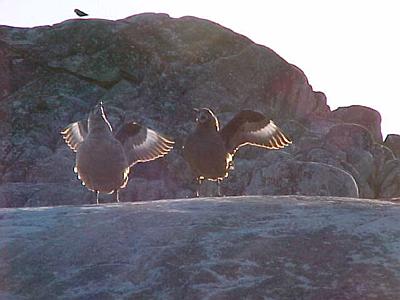
Skuas displaying.

Attacking skua.
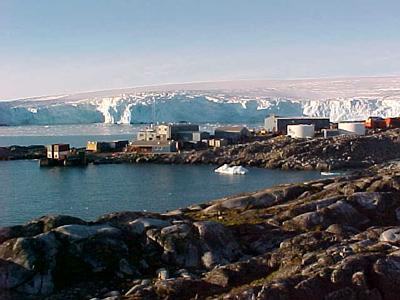
Palmer station.
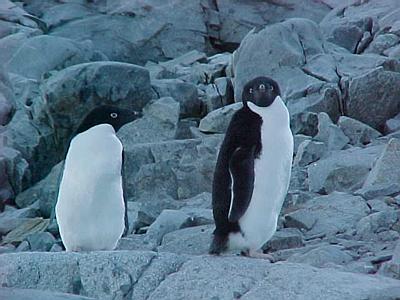
Pair of Adelie Penguins.
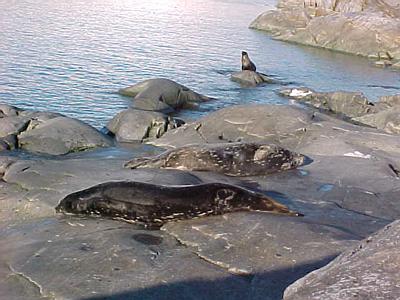
Weddell Seals hauled out on Bonaparte Point with a Southern Fur Seal behind.

Growling fur seal.
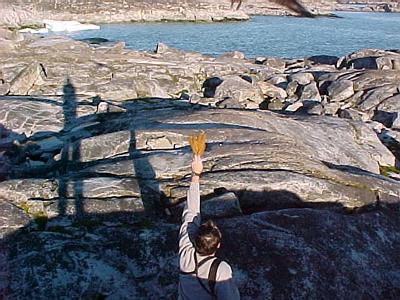
Bruce giving a skua an alternate target.
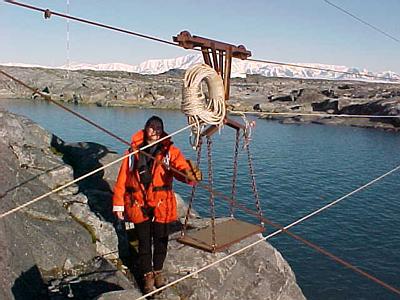
The trolley to Bonaparte Point.

Contact the TEA in the field at
.
If you cannot connect through your browser, copy the
TEA's e-mail address in the "To:" line of
your favorite e-mail package.
|
